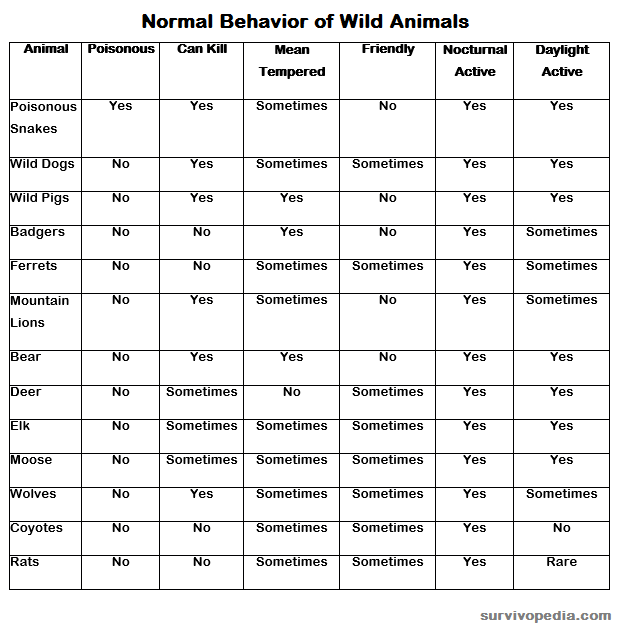Cities and towns may not often experience visits from bears and other large wild animals, but abandoned properties may eventually cause these, and other animals to draw closer to where you are living.
Needless to say, if you find yourself living in the wilderness after a major crisis, it is important to have basic knowledge of how to live around wild animals. There are certain actions that may cause a wild animal to charge or to run away.
To best handle a wild animal attack, you need to know and understand the behavior of the animal, know when an attack is coming, and do your best to stay calm and get through the situation with as little harm to yourself as possible.
How to React When Meeting a Wild Animal in the Wilderness
Do not panic
When in the wild do not panic if you come across a wild animal in you path. If you do panic the wild animal could misinterpret it as an offensive action and take on a defensive stance in self-defense. Most wild animals big or small will not attack unless they feel threatened, have young with them, or they are injured/sick.
Give the Animal A Way to Escape
In most cases, if the animal has a way to leave or escape the area it will do so. It is safer to do this than corner a wild animal and have to fight it. If the wild animal is a bear, mountain lion, or an adult moose, this fight could be to the death. These animals are bigger, stronger, and have claws, strong teeth, hooves or horns to defend themselves. If you are not killed there is a good chance of very severe injuries.
Slowly and Quietly Back Away
If confronted with a wild animal in, it would be to your advantage to quietly and slowly back track down the path. Keep an eye on the animal or animals until you are safely away. The more distance between the animal and you, the better..
Beware of the Animals that Are Sick
There are many diseases and health problems that can effect wild animals. Under these conditions the infected animal may not be in its right mind and act strangely or even attack an adult or child.
Here are some diseases that may cause an animal to attack even if you did everything possible to prevent a problem.
Rabies
Rabies is a viral disease which causes inflammation of the brain and is usually fatal. Infected animals may go for months without showing classic symptoms. Animals with Rabies suffer from deterioration of the brain. Sometimes there is a display of bizarre and aggressive behavior.
This disease is transmitted by an infected animal biting another animal or a person; and can be passed along by both humans and animals.
The four stages of Rabies:
- Surprisingly, after infection, the animal may appear normal for several days, months, or even a year. During that time, the virus moves through muscle tissue and eventually reaches the nervous system and brain.
Day 1 to 3 (after infection reaches the brain) Characterized by behavior changes such as making unusual sounds, nocturnal animals will be out in daylight hours, etc.
- Day 3 to 4 – animal may become hyperactive and bite at anything near. Other animals will lay still or try to stay away from everything.
- Final stage – The animal has visible signs of brain damage including uncontrollable drooling, difficulty swallowing, and paralysis of face and throat muscles. The victim cannot swallow and the concentrated virus saliva pours out of the mouth.
- Death is usually by respiratory failure.
Distemper
Canine Distemper is a highly contagious and often fatal viral disease transmitted through direct physical contact with an infected animal.
{adinserter emp}It affects both domestic dogs and wild meat eating animals such as foxes, wolves, coyotes, skunks, raccoon, and ferrets. Canine Distemper cannot be transmitted to humans, although it is a rapidly evolving disease with some strains that can also infect cats.
This virus attacks the respiratory, nervous, and the stomach and intestinal systems. Symptoms include fever, eye and nose discharge, vomiting, diarrhea, labored breathing, and an emaciated appearance. Most deaths are caused by muscle incoordination, muscle spasms, deterioration of mental skills, and seizures.
Wild animals with Canine Distemper appear to act tame or confused and wander aimlessly. They appear to have lost all fear of man. Do not approach or touch these animals since they might have Canine Distemper or Rabies. Both diseases share many of the same symptoms.
Anthrax
Anthrax is an acute bacterial disease caused by Bacillus Anthralis. Most forms of the disease are lethal and affects both humans and animals. It is also important to note that Anthrax Spores can be used as a biological weapon or used in bio terrorism. Therefore, this is one “wilderness” disease that even city dwellers need to be aware of in a time of crisis.
Anthrax is easy to mass produce and to deploy – all you need is an aerosol can to spread the Anthrax Spores. It should also be noted that since year 2000, the USDA allows meat with puss, tumors, sores and ulcers in it to be processed for human food.
While there do not appear to be anthrax outbreaks caused by this “reclassification” of tumors etc as “aesthetic issues”, perhaps consuming meat should be done with more care.
- Anthrax commonly infects wild and domestic herbivorous mammals (sheep, goats, or cattle) that ingest or inhale the spores while grazing.
- Carnivores (meat eaters) can become infected when they eat an infected animal.
- Diseased animals can spread the disease to humans by direct contact (infected blood contacts broken human skin) or by eating diseased meat.
- Anthrax does not spread directly from one infected animal or person to another. It is spread by spores.
- Spores can be transported on human clothes or shoes. The body of a dead animal that died of Anthrax is another source of spores.
- Anthrax has broken out in wild animal populations with some regularity.
There are 3 ways that Anthrax can affect the bodies of humans, domestic animals, and wild animals.
Skin Anthrax – This form of Anthrax occurs when the spores come into direct contact with skin of humans, wild animals, or domestic animals.
- Itchy sores develop similar to an insect bite. The sore may blister and forms a black ulcer.
- Sore is usually painless, but has surrounding swelling.
- A scab forms and falls off in 2 weeks, however complete healing takes a little longer.
Inhalation of Anthrax Spores – This form of Anthrax occurs when a human, wild animal, or a domestic animal inhales spores and they get into the lungs.
- Symptoms begin with a fever followed by headache, cough, shortness of breath, and chest pain.
- High fever and shock may occur later.
- May cause internal bleeding, swelling, tissue damage, and then death.
Gastrointestinal Contamination by Anthrax Spores – This form of Anthrax occurs when humans, wild animals, or a domestic animals eats the flesh of a contaminated animal.
- Usually occurs within 1 week.
- May include abdominal pain, bloody diarrhea, fever, mouth sores, nausea and vomiting, and death.
Treatment for Anthrax – The treatment for Anthrax is with antibiotics and IV fluids. The antibiotics most commonly used are Penicillin, or Doxycycline.
What Animals to Beware Of
The Table below gives information on animals and basic information on how they normally act.

In a time after a major crisis it is important to know how to react to wild animals. Take the time now to learn how to control your fear and panic, and also how to leave the area. There are many diseases that can infect humans, wild animals, and domestic animals and change their behavior from the normal.
Knowing about these differences, and getting to know the nature of various animals can be of immense benefit regardless of where you wind up after a crisis.






















































































I would have preferred to have read some citations to references, particularly regarding anthrax, so I could review the same “better” source info that presumably the Southern Gentleman is aware of. Mercola.com cites references and source materials for the teaching, or conclusions, it draws about health matters. Natural News often does this also. The lack or inability to cite references makes me wonder if the author’s memory is failing. Why is it that survivopedia (that I enjoy reading) never cites source material? My conclusion is that when survivopedia loses its focus, it reverts to producing “drama” (that never needs to cite any reference) because after all, when the purpose is drama, the purpose is not to educate.
We are just about to change that, in order to provide the readers all the answers that they need.
Thank you for your feedback, radarphos.
I have a problem with asking for a reference. 1. I can cite over a million references to substantiate that alien life has landed on earth. But seriously do you believe it? If someone states something that either you don’t believe or that is significant in your mind then do the research yourself. 2. Most calls for reference are nothing more then a way to marginalize the issue. As in no reference and therefore it must be untrue. Well grow up, a lot of things are true and at any moment in time I might not be carrying around proof or citations.
Would a small but loud air horn blast scare away, say a bear or mountain lion?
Sometimes, but I would not want to bet my life on it. Especially with bears.
One thing is for certain. One simply CANNOT forsake their ammunition supply for defensive firearms. Too much is never gonna be enough, especially when everyone is forced to leave the cities for whatever reason in masses.
Two picky observations:
In a scientific binomial the trivial name is not capitalized. “Bacillus Anthralis” should be expressed “Bacillus anthralis”.
To my knowledge there are no poisonous snakes anywhere , which is to say you may safely eat the meat. There are, however, dangerous venomous snakes. “Venomous” and “poisonous” do not mean the same thing.
I see coyotes during the day all the time …
One of the most important issues to the potential attacking wild animal, usually the factor used by it to determine whether an attack would be in there own best interest, is the size of the prey. This is of course only valid if the animal is not sick or with offspring. You, as potential prey, must establish yourself as the biggest of the two, not the aggressor just the biggest. Before backing away and giving room for its retreat, stomp both of your feet firmly and forcefully upon the ground. Make your weight seem, in a vibrational way, much more than it really is. Whenever I hike I always use two walking sticks. This makes me vibrate the ground even more, sending shock waves in all directions. The walking sticks also gives me some measure of safety against a quick strike or a misstep leading to a sprained or broken limb, or worst case situation, a crutch with which to get out. Animals have a keen sense and connection to the ground. You will likely never “surprise” a rattlesnake or any other wildlife if you use walking sticks when you hike. Train yourself to respond to any trail surprise with a stomp, it must be an automatic response if you would rather not use your walking sticks to fend off an attack.
Coyotes not “daylight active”, SERIOUSLY?